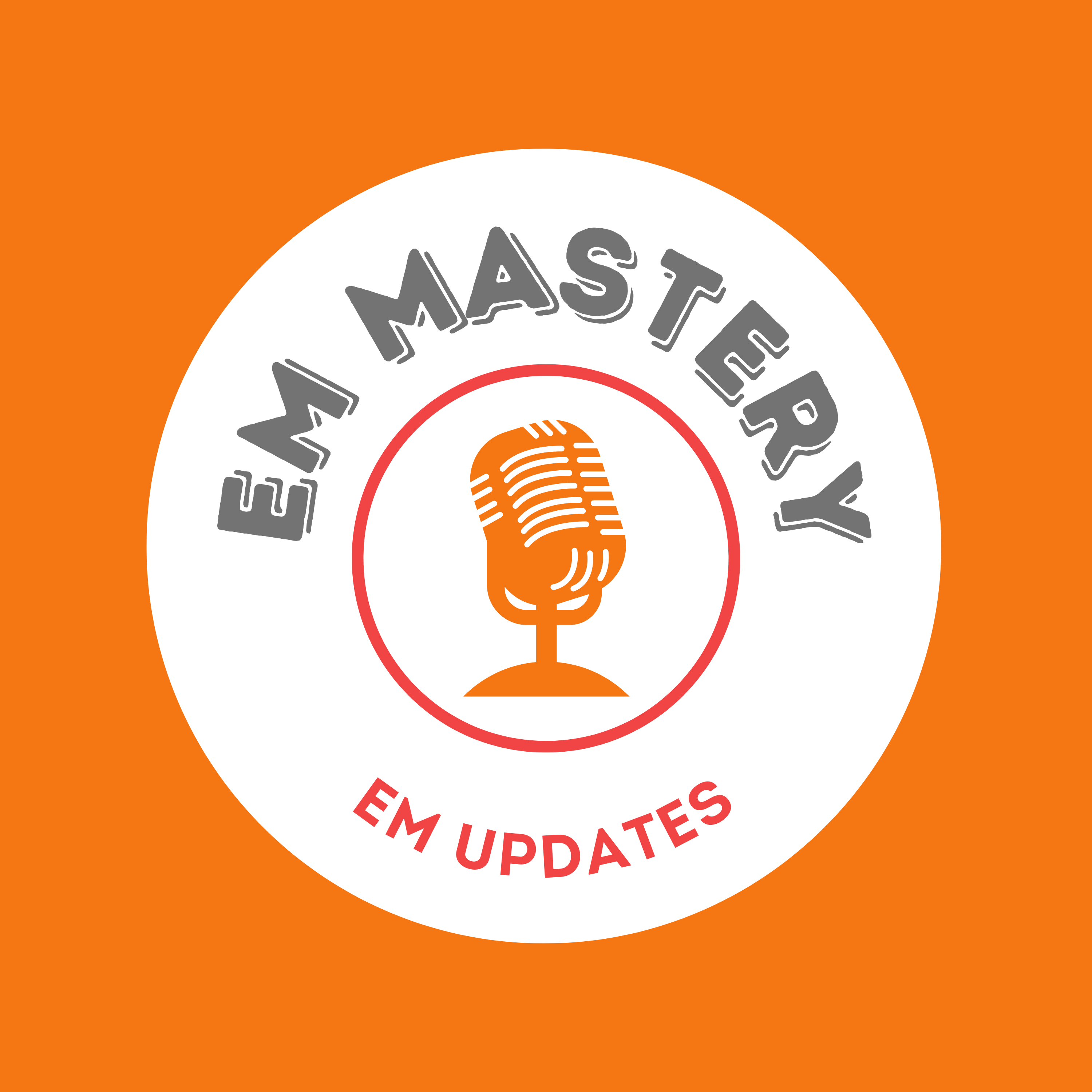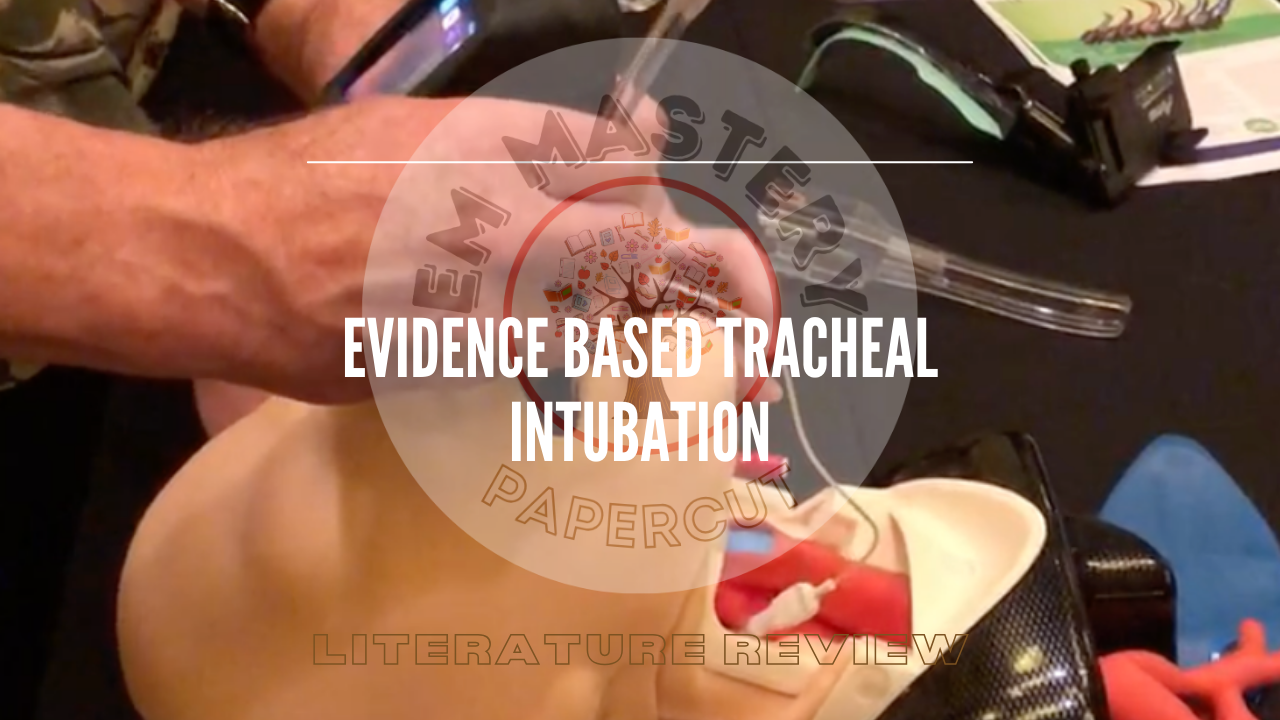The Study
DeMasi SC et al. Evidence-based Emergency Tracheal Intubation. Am J of Resp and Crit Care Med. 2025:211: pp 1156-1164
This review looks at the evidence from randomised trials for intubating critically ill patients.
Other reviews on EM Mastery that compliment/reinforce this airway article include:
- The PREOXI Trial
- Airway Pearls for Intubating the Obese Patient
- Induction Agent Administration sequesnce and first attempt failure
- VL vs DL for intubating Newborns
- Does paralysis first decrease first pass failure rates?
- Effect of reduced dose induction agent on post intubation hypotension
- Cardiac Arrest complicating emergency airway management
- VL vs DL for critically ill patients: The DEVICE Trial
- Resuscitative Sequence Intubation
Oxygenation and Ventilation
Hypoxemia:
- Occurs during 10–25% of all emergency tracheal intubations
- Occurs at a higher percentage where intubations are for acute hypoxemic respiratory failure
- During intubation, increases the risk of cardiac arrest and death
- During intubation it occurs due to:
- the underlying illness:
- pulmonary shunt,
- ventilation-perfusion mismatch
- increased oxygen consumption
- the intubation procedure:
- apnea secondary to sedation and paralysis paralysis
- decreased residual capacity from supinepositioning
- the circumstances of the procedure:
- limitedtime for preparation
- longer procedural duration
- greater number of intubation attempts
- limitedtime for preparation
- the underlying illness:
What interventions might prevent hypoxemia?
Preoxygenation Stage
During preoxygenation ie., before induction, the patient can be given supplemental oxygen
- Three randomized trials have found that patients treated with non-invasive ventilation(NIV) had a lower incidence of hypoxaemia (1-3). The PREOXI Trial is a practice changing trial that found that NIV reduced the incidence of hypoxaemia from 18.5% to 8.1% and the incidence of cardiac arrest from 1.1% to 0.2%.
- High-flow nasal cannula(HFNC) can also be used for pre-oxygenation, although its ability to prevent hypoxemia during intubation is uncertain. It may also not be as successful as NIV. (4)
Induction to Laryngoscopy
This is the time between administration of medication and paralysis. Should we bag valve mask (BVM) during this period, use NIV or do nothing?
The recent PreVent Trial was an ICU trial comparing BVM to no ventilation. BVM ventilation reduced the incidence of hypoxemia from 22.8% to 10.9%. Aspiration was also lower in the BVM group (2.5% vs 4.0%).
During Intubation
Supplemental oxygen either via nasal cannula or HFNC, often called apnoeic oxygenation, does not appear to affect the lowest saturations during laryngoscopy and intubation.(5-8)
Medications
Induction Medication
Sedative medications are used to induce anaesthesia, to ensure the patient is unconscious and to facilitate laryngoscopy. Propofol, although intitially popular, is used less, due to its association with higher rates of hypotension(9).
Etomidate and ketamine are the most used induction agents with Ketamine having a better survival profile (10-12).
Neuromuscular Blocking Agent
Neuromuscular blocking agent is intended to relax the muscles of the head and neck to facilitate laryngoscopy. The include the likelihood of success at first pass and to make BVM easier.
The two most commonly used neuromuscular blocking agents are succinylcholine and rocuronium. Succinylcholine has been a popular paralytic agent due to it’s short duration of action (6 to 10 minutes). However it is a ssociated with side efdfects which include: rhabdomyolysis, malignant hyperthermia, and hyperkalemia
Althoigh there is no rogorous research to show that one drug is better than the other, Rocuronium has become the more popular drug. It has a longer duration of action (30-90 minutes) but does not have these side effects. The initial concern of rapid onset time are corrected by giving a higher dose (1.2mg/kg)
Laryngoscopy and Trachel Intubation
Larynggoscopy allows for the visualisation of the vocal cords and insertion of an endotracheal tube into the trachea.
Videa laryngoscopy(VL) has become the preferred method of intubation over Direct Laryngoscopy(DL).
The DEVICE trial, found that first intubation attempt success was 85.1% of VL vs 70.8% of DL, with the greatest positive effect being with those clinicians with lesser intubating experience.
Standard geometry VL blades appear to be the most widely used and they approximate the shape of a Macintosh-style curved direct laryngoscope blade. Hyperangulated VL blades allow visualization of the vocal cords without significant jaw manipulation
Device for Intubating the Trachea
Devices such as an intubating stylet or a bougie may be used to assist inpassing the endotracheal tube through the cords.
The STYLETO Trial showed a 78.2% success rate of first attempt at intubation with a stylet vs 71.5% of patients where the endotracheal tube was used alone.
The BEAM Trial found that most intubations that successful intubation on the first attempt
- occurred in 98% of patients in the bougie group and
- 87% of patients in the stylet
The BOUGIE trial found that succesful intubation rates on first attempt were found in:
- 80.4% of patients in the bougie group and
- 83.0% of patients in the stylet group.
Endotracheal tube sizes are also inportant. Larger endotracheal tubes (internal diameter of 8.0 mm or taller patients and 7.5 mm for shorter patients) have been associated with injury to the vocal cords.
Hypotension during Intubation
Hypotension associated with tracheal intubation occurs in up to 40% of procedures and is associated with an increased risk of cardiac arrest and death. (13).
The following mechanisms contribute to this hypotension:
- Vasodilation and decreased endogenous catecholamine release from induction medications,
- Decreased venous return and cardiac output following the initiation of positive pressure ventilation.
The two treatments most commonly proposed to prevent the development of hypotension during emergency tracheal intubation are the administration of an intravenous fluid bolus or the administration of vasopressors before or with induction.
The PrePARE and PREPARE II trials, were randomized trials demonstrated that administration of a fluid bolus did not prevent hypotension, or cardiac arrest.
The use of vasopressors either as a ‘push’ dose or an infusion is often used to prevent hypotension, however there are no completed randomized trials that demonstrate that vasopressors prevent hypotension or cardiac arrest. (14)
SUMMARY
Summary
- In order to minimise hypoxaemia during intubation, patients should be pre-oxygenated with NIV. If there is a contraindication to this, then HFNC should be used.
- If there is no contraindication positive pressure ventilation should be delivered from induction to laryngoscopy.
- Apnoeic Oxygenation does not appear to add to the prevention of hypoxaemia.
- Ketamine appears to be the induction agent of choice and is associated with lower mortality
- Rocuronium has become the more popular drug, with a better safety profile and similar onset time to succinylcholine.
- Video laryngoscopy(VL) has become the preferred method of intubation over Direct Laryngoscopy(DL).
- The use of a stylet or bougie is better than a tube alone.
References
-
Gibbs KW, et al.; PREOXI Investigators and the Pragmatic Critical Care Research Group. Noninvasive ventilation for preoxygenation during emergency intubation. N Engl J Med 2024;390:2165–2177.
-
Baillard C, et al. Noninvasive ventilation improves preoxygenation before intubation of hypoxic patients. Am J Respir Crit Care Med 2006;174:171–177.
-
Baillard C, et al. Effect of preoxygenation using non-invasive ventilation before intubation on subsequent organ failures in hypoxaemic patients: a randomised clinical trial. Br J Anaesth 2018;120:361–367
-
Lyons C, et al. Pre-oxygenation with facemask oxygen vs high-flow nasal oxygen vs high-flow nasal oxygen plus mouthpiece: a randomised controlled trial. Anaesthesia 2022;77:40–45.
-
Semler MW, et al.; Pragmatic Critical Care Research Group. Randomized trial of apneic oxygenation during endotracheal intubation of the critically ill. Am J Respir Crit Care Med 2016;193:273–280.
-
Caputo N, et al. Lincoln Airway Group. Emergency department use of apneic oxygenation versus usual care during rapid sequence intubation: a randomized controlled trial (the ENDAO trial). Acad Emerg Med 2017; 24:1387–1394.
-
Jhou H-J, et al. High-flow nasal cannula therapy as apneic oxygenation during endotracheal intubation in critically ill patients in the intensive care unit: a systematic review and meta-analysis. Sci Rep 2020;10:3541.
-
White LD, et al. Oxygenation during the apnoeic phase preceding intubation in adults in prehospital, emergency department, intensive care and operating theatre environments. Cochrane Database Syst Rev 2023;8:CD013558.
-
Russotto V, et al. Peri-intubation cardiovascular collapse in patients who are critically ill: insights from the INTUBE study. Am J Respir Crit Care Med 2022;206: 449–458.
-
Wunsch H, et al. Evaluation of etomidate use and association with mortality compared with ketamine among critically ill patients. Am J Respir Crit Care Med 2024;210:1243–1251.
-
Chan CM, et al. Etomidate is associated with mortality and adrenal insufficiency in sepsis: a meta-analysis. Crit Care Med 2012;40:2945–2953.
-
Brown CA, et al; NEAR III Investigators. Techniques, success, and adverse events of emergency departmentbadult intubations. Ann Emerg Med 2015;65:363–370.e1.
-
Perbet S, et al. Incidence of and risk factors for severe cardiovascular collapse after endotracheal intubation in the ICU: a multicenter observational study. Crit Care 2015;19:257.
-
Baillard C, et al. Effect of preoxygenation using non-invasive ventilation before intubation on subsequent organ failures in hypoxaemic patients: a randomised clinical trial. Br J Anaesth 2018;120:361–367.




